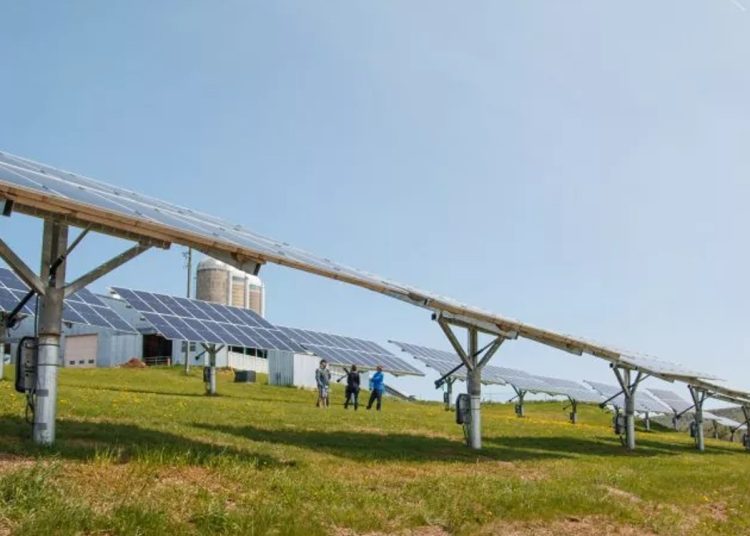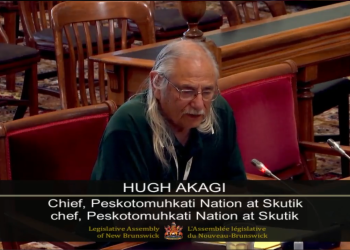The global energy landscape is undergoing a rapid paradigm shift driven by the need to reduce greenhouse gases. Accelerating that shift is the realization that the inexpensive power produced by wind turbines and solar panels can form the foundation of highly reliable electrical power grid. At the same time there is the growing realization that to have a healthy and prosperous future for all, we also need to support the sustainable mining of resources, maximize the reuse and recycling of resources and recognize the limits of a finite planet.
New Brunswick can realize that healthy and prosperous future by starting with a plan for a deliberate transition in how we produce and consume energy. That plan should be based on wind turbines, solar panels, hydropower, geothermal energy and energy storage which are all proven renewable energy technologies.
Currently, wind is the cheapest source of energy while sunlight is not far behind. Combining renewable energy sources with storage and interties including the Atlantic Loop, will result in an electrical power grid which reliably provides clean and affordable power.
Even better, the cost and efficiency of renewable energy technology continues to improve almost every year. Those improvements are happening quickly, in part, because of the fast pace of deployment of those technologies. Of course, meaningful community consultation and engagement are essential first steps in deploying any power technologies. When communities are on board, construction of wind farms or solar arrays often require only months after which the experience and learnings can apply to future installations.
Electrify everything!
For many emission-reduction experts the rallying cry is “Electrify everything!” The International Energy Agency agrees: “Electrification holds great potential to reduce final energy demand…” and “…the emission reduction benefits from electrification go hand in hand with an increase of renewable energy.“ Some experts say that using solely renewable sources can reduce energy needs by over 50 per cent.
Sources of renewable energy, by their very nature, do not require fuels. As mining slows for fuels such as oil, gas, coal, and uranium, the

mining will increase for the materials required for renewable energy facilities. Unlike fossil fuels, which are simply burned, most of those materials can be used, reused, and recycled for a very long time.
Even so, it is important to use sustainable mining practices in the extraction of these materials. Destructive mining practises have had huge negative impacts on the environment and local communities, particularly Indigenous communities around the globe. One response to that destruction is the “Manifesto for an Ecosocial Energy Transition from the Peoples of the South” which is calling for a “radical, democratic, popular, gender-just, regenerative, and comprehensive ecosocial transition.”
Two of the largest areas of energy use in New Brunswick are transportation and building heating. Here are some of the affordable solutions already available to electrify each of those areas.
Transportation
Public transit, shared vehicles and especially active transportation, such as walking and biking, are the best options for reducing overall energy consumption. However, for those who need to have a personal vehicle, the cost of a fully battery electric vehicle (BEV) has become affordable and for many, especially high mileage drivers, the total cost of ownership is far cheaper than that of a gas or diesel vehicle.
A BEV is cheaper to run in large part because they are so efficient. The Canada Energy Regulator calculates that a fossil fuel vehicle uses only 16-25 per cent of the energy of the fuel to actually move the vehicle. In contrast, 86-90 per cent of the electricity consumed by a BEV is used to move the vehicle.
BEVs come in all shapes and sizes such as buses, local delivery vehicles, garbage pickup trucks, and even Class 8 trucks, a.k.a. “semi-trucks.” Canadian public jurisdictions and private companies are moving electric vehicles into their fleets. That includes some New Brunswick communities which have started ordering/using electric transit buses and school buses.
Home and building heating
In 2021, residences used 20 per cent of the energy consumed in New Brunswick. Over 60 per cent of residential energy is for air heating. Heat pumps are far more efficient than conventional heating methods since they do not create heat, they simply move it. Many home owners in New Brunswick are taking advantage of heat pumps especially the cold climate models which are now available.
Many countries use ground-sourced heat pumps with district heating systems to reduce costs and ensure efficient heat on the coldest of days. In the summer, the heat pumps cool homes by moving heat into ground storage. Months later in the winter, the system draws upon that heat to warm those same homes. This type of district heating with storage is already in used in other countries such as Denmark and has been in use in Okotoks, Alberta since 2004. Recently the University of Toronto began installing such a system during their major campus renovation with an expected completion in 2024.
Lastly, insulation and sealing are two of the most effective tools for increasing building heating efficiency. Homes using the latest version of the building standards R-2000 or PassiveHouse save significant amounts of energy.
Moving ahead
Our province has great potential for building a clean reliable economic energy system with our excellent renewable energy resources as a foundation. Our wind resources alone could easily meet all of our needs with plenty of energy to spare. The technology to make use of those resources effectively and efficiently exists today. We just need to use it.
Tom McLean is with the Coalition for Responsible Energy Development in New Brunswick (CRED-NB).






![Day 1: Social Forum in Wolastokuk [video]](https://nbmediacoop.org/wp-content/uploads/2025/10/SocialForum-2-120x86.jpg)



